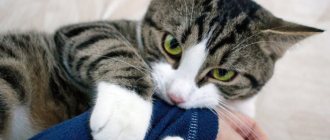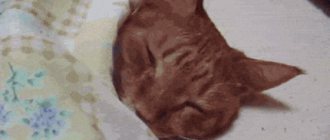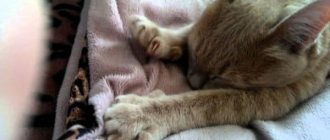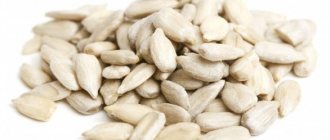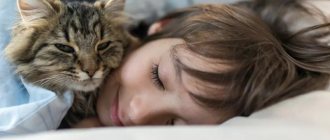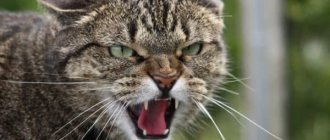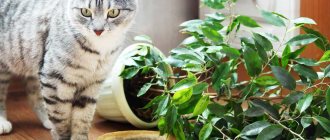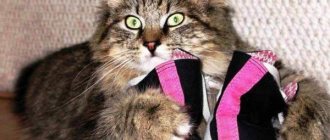First of all, don't worry and calm down. This is a very common bad habit of cats. They most often lick, suck and chew woolen items, but they may also choose other types of fabric or objects such as human hair, plastic or paper bags, shoelaces, clothing, and bedding. It is a self-comforting obsessive-compulsive behavior similar to thumb sucking in human children.
Most often this is not associated with health problems, however, there are several diseases (such as anemia, diabetes, mineral deficiencies, feline leukemia, feline immunodeficiency virus, brain tumors) that can cause this behavior, so it makes sense Get examined by a veterinarian to rule out any medical causes.
Reasons for the habit
A deviation in pet behavior in which a cat sucks or licks clothes, blankets, carpets, its own fur or the tail of another animal is called “sucking syndrome.”
Veterinarians identify the following factors influencing the appearance of the habit:
- The kitten was weaned from its mother before 8 weeks. The problem arises due to lack of care and concern on the part of the cat.
- Various diseases. These include brain tumors, diabetes mellitus, anemia, lack of vitamins and minerals, leukemia, and immunodeficiency virus.
- Stress suffered by animals. Separation from the owner, moving to another apartment, the birth of a child, divorce, unsanitary conditions can lead to such deviations in behavior even in adults.
- Lack of attention. In this way, the pet tries to attract the attention of its owners.
- Sedentary lifestyle. The addiction occurs in cats that do not go outside. Due to lack of stimulation and physical activity, the cat becomes bored and thus seeks care and attention.
- Breed. Scientists have proven that cats of oriental origin are prone to bad habits.
Materials for blankets and bedspreads
- satin or polysatin - natural, cotton or artificial, polyester fabric. Smooth front surface, matte back;
- The tapestry is distinguished by its textured surface and complex patterns. The creation of the pattern occurs during the process of making fabric using yarn of various colors. Sometimes whole stories are woven. The yarn contains cotton, wool, silk, polyester. The bedspreads are very expensive, but practical: they wash well and last a long time. It is all the more annoying to see that the cat uses the textured surface of the bedspread as a scratching post, the pattern is broken and the thing is damaged;
- Many people confuse jacquard and tapestry, because in both cases the design is not applied by printing, but during the production of the canvas. But there is a difference: jacquard has a satin weave, a denser and smoother texture, a minimal set of colors and patterned (not plot) patterns. Jacquard bedspreads are very beautiful, but claw marks ruin them;
- microfiber is a fleecy fabric of artificial origin, very soft and pleasant to the touch. The pulled out fibers are not so noticeable on it;
- percale - thin, dense, smooth fabric;
- artificial leather and suede. The velvety texture of the materials is very attractive to pets, but claw marks are less noticeable on suede;
- velor and flock have pleasant, moderately fleecy textures. They are ideal for bedspreads in a house where there is a cat - they look beautiful and expensive and the pulls are invisible;
- fleece (coral fleece, velsoft) and faux fur - soft, fleecy textures. Velsoft can be washed in a washing machine, but fur is dry clean only.
Let's summarize. To make bedspreads for a bed or blankets for a sofa in a house where there are cats and small dogs, fleecy textures are ideal; claw marks will be visible on smooth and textured surfaces.
But you need to understand that the more fluffy the blanket, the more animal hair it traps. So it turns out that the ideal materials are artificial suede, velor and flock.
And one more proof - go to furniture showrooms and ask to show you the range of upholstery fabrics that are recommended for homes with pets. You will see that these are fabrics of a similar texture.
And don’t forget that there should be no decorations like tassels on the bedspreads: animals love to play with them and end up tearing them off.
Why is it dangerous?
If the pet then starts eating the owner's things, the risk of intestinal obstruction increases.
First of all, it is necessary to find out the reason for this behavior of the pet in order to exclude serious diseases. If the animal is healthy, then the worst thing is when the cat goes from sucking things to chewing and swallowing them. Which can lead to blockage of the esophagus and intestinal obstruction, and such conditions often result in death. If the fabric is synthetic or contains toxic dyes, the animal will develop severe intoxication.
Why does a cat lick the floor and walls?
If a cat licks walls, concrete surfaces, wallpaper, or eats chalk with pleasure, the reason should be sought in functional system failures in the body, which are provoked by the deterioration of the furry pet’s health.
As a rule, this behavior of cats is provoked by a deficiency of macro-microelements in the animal’s body. If a cat begins to lick the floor, the wall is littered with marks from the cat’s teeth; one of the possible reasons is hypocalcemia. Characterized by a violation of phosphorus-calcium metabolism. The disease develops due to a deficiency of calcium and vitamin D3.
When a cat wants to lick walls, some of the reasons for this condition include:
- hypovitaminosis;
- endocrine pathologies;
- metabolic disorder;
- gastrointestinal diseases;
- helminthic infestations;
- unbalanced diet;
- liver problems.
If a cat licks the floor, concrete, walls, tiles, another common cause is anemia, which develops in animals against the background of iron deficiency. In this condition, the mucous membranes turn pale, the cat looks depressed, lethargic, and the digestive processes in the body are disrupted.
Note that anemia can be a symptom of viral and bacterial infections and diseases of various etiologies. Therefore, if you notice uncharacteristic behavior of your cat or symptoms indicating deterioration in health, take your pet to the veterinary clinic for an examination.
How to wean it off?
In order for a cat to stop sucking a blanket, the very first thing you need to do is eliminate or reduce the number of objects around that can be used for sucking. No source, no problem. You can repel with a spray bottle of water or aromatic oils with citrus scents. Veterinarians also insist on conducting a full examination and identifying possible causative diseases or complications. If a deficiency of nutrients and vitamins is detected, the cat is prescribed a special diet.
It is important to distract the student from unwanted games. Especially important are those that will develop trust between the purr and the owner. When you see your pet doing an obscene activity, you need to distract him for at least 10-20 minutes so that the cat’s brain has time to switch. At the end of the game, you can pet the animal or offer it a treat. Then he will enjoy the entertainment, and not from sucking on the blanket. It is important to provide the child with toys that will not let him get bored during the day when the owners are at work.
Breeders remind you that care should be taken to have several scratching posts, high shelves or a whole complex. The tray and feeding area should be kept clean. Then the animal will feel comfortable and safe. You should never punish or beat someone for bad behavior or strange habits. On the contrary, you need to surround your pet with care, affection and attention, then he will not have the desire to attract attention to himself by sucking on the blanket.
Additional accessories
However, owners can take other actions. For example, you can place a scratching post next to the bed in the bedroom and gradually the cat can start sharpening its claws on it. Also:
- brush the animal regularly;
- trim your nails.
The now popular silicone claw caps are an attractive solution only at first glance. Animals never stop sharpening their claws, so sooner or later the pads will tear, but this is not the worst option. Sometimes the pads come off along with the claws, and this is very painful.
This is by no means an outdated part of home textiles. Modern cases are distinguished by style and functionality.
Eucalyptus fiber in home textiles is used as a filler for pillows, blankets, mattress covers and belongs to the plant group. In the article we will talk about the advantages and disadvantages of the filling and the features of caring for a pillow or blanket so that it serves you for a long time.
Usually this question arises in relation to calico, but in fact it applies to all types of fabrics.
Very often, owners of furry pets notice that a cat crumples a blanket, bed or human body with its paws. Sometimes this happens before they are about to lie down or after eating. Not all owners understand why cats knead the blanket with their paws and purr. And there are at least eight different reasons for this, which can tell a lot about the character of the pet. Read more about why this happens and what effect it has on a person below. After this, you will begin to appreciate the cat’s attention more and even learn to take advantage of the benefits of such a massage.
World of cat scents
By the way, cats also have unloved odors:
- Cats are not fond of citrus scents. If you put the skins of oranges or lemons in the pot of a flower that your pussy is nibbling on, it will ignore that place.
- You can spray the area where you don't want a cat's presence with acetic acid. Cats cannot stand this smell. It will seem to a person that it has disappeared within just a few minutes, but your mustachioed friend will feel it for a very long time.
- Lavender, mint, and rue are suitable as natural “horror stories.” They can be placed in a garden area where there is no place for cats.
- You can buy cat repellent spray in specialized stores. The method of application is simple: where the cat has adapted to walk “big”, you need to spray the spray. Animals avoid such places; they don’t like them.
A person in modern society is simply obliged to observe the rules of personal hygiene, smell nice and look neat.
But what to do if all the rules are followed, but an unpleasant odor still emanates from the body? Every person, under certain conditions, tends to sweat. The smell of sweat is different for everyone, but it happens that the sweat takes on a sour smell, the smell of ammonia, vinegar, or even worse - the sweat smells like cat urine. Human sweat consists of 99% water, and 1% urea, salts, acids and other chemical compounds. If he starts to smell like cat urine, this indicates an increased secretion of urea and uric acid. These substances settle on the hairs in the form of crystals and cause unpleasant odors. Moreover, a similar phenomenon is observed in both women and men. People’s first reaction: what will others think of me, will they judge me, criticize me. But in this situation, you need to think not about the gossip around you, but about your own health, since any unpleasant body odor can be a symptom of very serious diseases of vital organs. In this case, get tested as soon as possible.
To maintain cleanliness
Self-licking is a natural and very common mechanism for caring for one's own body in the animal kingdom.
Cat licking rituals like these are a demonstration of love for cleanliness:
- The cleanest. Sometimes it seems that keeping oneself clean is the main task of a feline brother. Taking the most graceful poses, Murka licks herself for hours, touchingly washes her face with her paws and rubs her ears. She does this many times a day: after sleeping, feeding, taking care of her natural needs, and even stroking her. A cat's tongue, covered with miniature hooks and therefore rough to the touch, combs and arranges hairs like a brush, removing dirt and foreign odors. During this massage, blood flow is stimulated and the skin glands intensify the production of an oily secretion, which lubricates the hair and protects it from moisture.
- “No” to foreign odors. The desire to lick a person may be motivated by the desire to destroy unusual scent marks. According to the cat's understanding, all perfumes, including perfumes, soaps, shampoos and creams, have unnatural and even unpleasant odors, which must be urgently gotten rid of. This is why the cat spends so much time and carefully licking its own area of the body with medicinal ointment applied to it.
- Tempting aromas. Some cosmetics, on the contrary, can be very attractive to mustachios. Such, for example, is a hand and nail cream with an extract of medicinal valerian, which has a magical effect on cats and activates the owner’s obsessive licking. Some cats love the smell of peony tincture and therefore tend to lick the hands or lips of a person who has taken this sedative. Cats are also attracted to human sweat, which contains odorous substances similar to animal pheromones. So the owner, returning from a morning jog or after a hard work shift, smells very attractive to the murka.
What to do if your cat licks eggs
Despite the fact that the saliva of our little brothers contains enzymes and substances that accelerate healing and tissue regeneration, it can also contain pathogenic microorganisms that will lead to the development of acute inflammation, suppuration, and infection. If a cat licks a wound, the natural healing process is disrupted.
In addition, the rough tongue of felines, especially with frequent intensive licking, can lead to sutures coming apart and bleeding. If a cat licks itself, treatment with antiseptics and disinfectants will not give the desired result and will increase the rehabilitation period. Therefore, you need to constantly monitor the cat and monitor the condition of the wounds daily.
Inspect the scrotum for signs such as redness, tenderness, and swelling. If blood oozes from the wound, severe bleeding has developed, the stitches have come apart, or greenish-yellow exudate is released, immediately contact your veterinarian and take your pet to the clinic. Make sure that no dirt gets into the wounds. If, for example, the postoperative area is contaminated with feces, clean the wound with warm water and a weakly concentrated solution of betadine. Dry the seam and lubricate it with antibacterial ointment.
Important! After surgery, consult with your surgeon regarding proper care. If, in addition to licking, the cat shows restlessness, rushes around the apartment, tries to hide in dark secluded places, constantly meows pitifully and this behavior lasts more than two days, consult a veterinarian
It’s better to be on the safe side than to correct serious consequences later
If, in addition to licking, the cat shows restlessness, rushes around the apartment, tries to hide in dark secluded places, constantly meows pitifully and this behavior lasts more than two days, consult a veterinarian. It’s better to play it safe once again than to correct serious consequences later.
Taking care of hygiene
Well, of course, when licking a person, a cat tries to clean his “skin”, just as she is used to caring for her kittens. In the wild, a strong smell can give away an animal and attract an enemy. To destroy it, the cat will carefully lick hands washed with scented soap or neck or hair scented with shampoo.
You should not show your cat dissatisfaction with such a toilet. If you often drive a cat away, avoiding its rough tongue, the emotional connection and trust in the person may be disrupted. Saving him from danger, endowing him with the aromas of his “group”, the cat expects recognition and affection in return.
